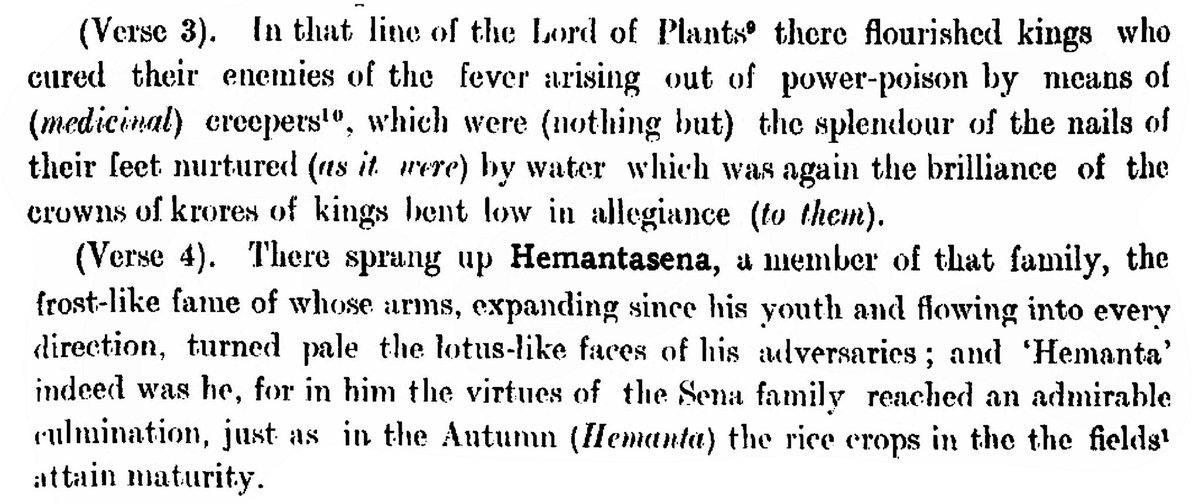A 🧵 on clarifying the uncertainties regarding the origins of the Sena dynasty of Bengal and refuting the notion of their Brahma-Kshatriya/Baidya origin. 

Commencing with the Deopara Stone Inscription attributed to Vijayasena, dating to the approximately 11th century CE, which notes that the founder of the Sena dynasty, Virasena, hailed from the esteemed lineage of the Moon.




The Barrackpur copperplate inscription of Vijayasena, dating back to 1158 CE, records that Samantasena was born into the lineage of the Moon.




The aforementioned inscription also refers to Samantasena as the ‘Head ornament of Kshatriyas’, rendered in the term ‘क्षत्रियणं’.
The Naihati Copperplate Grant of Vallalasena, dated 1170 CE, references Samantasena as a scion of the illustrious lineage of the crest jewel of Bhagwan Shiva (i.e., Moon).




In the pages of Adbhutasagara, a literary work credited to Vallalasena, Vijayasena (father of Vallalasena) is referenced as a distinguished member of the Moon's esteemed lineage. 

The Anulia copperplate inscription of Lakshmanasena notes that Hemantasena (great-grandfather of Lakshmanasena) was born into the esteemed lineage of the Lord of the Plants (i.e., Moon).




The same notion has been reaffirmed in the Govindapur and Tarapanadighi copperplate inscriptions of Lakshmansena.
The Madhainagar copperplate inscription of Lakshmanasena reveals that the founder of the dynasty, Virasena, hailed from the revered lineage of the head ornament of Bhagwan Shiv (i.e., Moon).




Furthermore, the aforementioned inscription designates Samantasena as the ‘कर्णाट क्षत्रियणं’ (lit. Head ornament of the Karnata Kshatriyas).
Again the aforementioned inscription refers to Lakshmanasena as both ‘सोमवंशप्रदीप’ (lit. Lamp in the lineage of Moon) and a Brahma-kshatriya.




This designation suggests a nuanced understanding, as it would not align with the interpretation of Brahma-Kshatriya as merely a ‘Brahmin who embraced martial pursuits’.
The Bakerganj copperplate inscription of Vishvarupasena records that Vijayasena, the great-grandfather of Vishvarupasena, was born into the noble line (dynasty) of the Moon.




The Madanapada copperplate inscription of Vishvarupasena elegantly references Vijayasena, the great-grandfather of Vishvarupasena, as a distinguished member of the great family of Moon.




Furthermore, this aforementioned inscription venerates the kings of the Sena dynasty, describing them as ‘सोमवंशप्रदीप’ (translated as ‘Lamp in the lineage of Moon’), a testament to their noble heritage. 

The Edilpur copperplate inscription of Keshavasena notes that Vijayasena, the great-grandfather of Keshavasena, hailed from the great family of the Moon.




A discourse elucidating the term Brahma-Kshatriya, frequently associated with the sovereigns of the illustrious Sena Dynasty. 👇
https://x.com/arjunvanshi_/status/1824650198318030881?t=GZNMfcUmuNBS8QJBqqOlvg&s=19
Abul Fazl, the courtier of the Mughal Empire, found himself in a perplexing situation, mistaking the Vallalasena of the Sena Dynasty for another Vallalasena, a prominent zamindar of the Baidya caste in Bengal. 

This unfortunate conflation led him to erroneously attribute the lineage of the Sena Dynasty to the Baidyas, thus casting a shadow of injustice upon the historical narrative.
The Varna Ratnakar, authored by Jyotirishwar Thakkura, which is the oldest surviving prose work in Maithili literature, elegantly enumerates Sena among the 72 clans of the Rajputs. 

After a meticulous dive into the treasure trove of contemporary and nearly contemporary sources regarding the Sena Dynasty, one can confidently assert that this dynasty was, without a doubt, a Chandravanshi/Somvanshi Kshatriya lineage, rather than a Brahma-Kshatriya/Baidya one.
@rattibha @threadreaderapp unroll
• • •
Missing some Tweet in this thread? You can try to
force a refresh


















